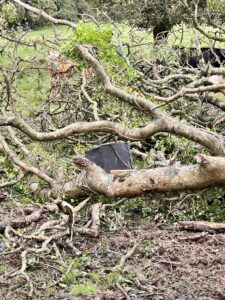As the Autumn weather draws in and leaves begin to brown and fall, we prepare for the long nights and cold days ahead. Stormy weather is always on the cards for this time of year and we have already had storm “Betty” pass through some weeks back.
Two mature trees fell to those high winds here. One a Monterey pine about 70/80 years old, and the second was a particularly beautiful old and well established ash tree in which we had placed one of our owl nesting boxes. We are estimating it to have been around 100 years old!

Always so sad to see such a majestic being fallen having been a presence in our surroundings and our imaginations for what feels like forever.
The ash was infected with ash die back, and had rotted at its core.
This fungal infection has had a devastating impact on our ash trees right across the country.
Some ash trees have displayed resistance to the disease, and there have been hopeful suggestions from scientists of developing a resistant strain from these. Many of the ditches here are lined with ash trees, they are a prominent feature.
Also present in the hedgerow here is the elm. Another highly prized tree which was devastated by disease. Dutch elm disease is caused by a fungus again, but it is spread by a beetle. The disease arrived in Europe in the mid 20th century and by the 1990’s had almost completely wiped out the elm population.

There are a number of young elms here. It gives us great pleasure to see one growing right by the edge of the pond which we made in our well field this year.
We will have this tested for resistance to the disease.
Other trees that you will see around the well field where we have introduced our small herd of alpaca are, willow, alder, furze, beech, oak, hawthorn, blackthorn, and a small stand of spruce and Monterey pine these have an under growth of elder and holly.
There are a lot of sycamore here too. These seem to really like it here and grow virulently. They are not in fact classed as a “native” species and are thought to have been introduced here in 1610. It was widely planted throughout the country by the 19th century, and is classed as invasive.
It has been suggested however that this non native tree grew in this region before the last ice age. But native or non native, it is a species that now supports as many associated ecosystems and species as the oak!
We have added some fifty hazel trees to mix in the well field. We planted nine of these around the well which now fills the pond as a nod to those stories of old and to the worshipping of wells that is such a deep rooted part of our history in Ireland. There are more holy wells on this Island than any where else in the world.

Trees have provided for many of our practical needs from when humans first began to shape tools right up to the present day. They have provided forus in so many practical ways, tools, shelter, heat, transport, construction, and medicine.
But trees have also had an important presence in our lores and mythology, having been imbued with much spiritual symbolism and were often indeed considered sacred.
There are also many superstitions attached to trees. Elder for example has been planted to protect from evil spirits, but also if burned can bring bad luck.
The ash tree has also had a strong link with holy wells. In Co. Roscommon, an ash tree that grew next to St. Patricks well was known as St. Patrick’s walking stick. St. Brigid too was associated with the ash tree, and in ancient mythology the ash is linked to queen Maedhbh, and three of the five great trees of Ireland were ash trees.
We will be keeping a close eye on what arrives in our hares corners and holding out for some pleasant surprises!
